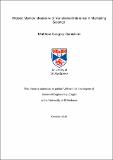Files in this item
Hidden Markov models with variational inference in marketing science
Item metadata
| dc.contributor.advisor | Nederhof, Mark-Jan | |
| dc.contributor.advisor | Cazzanti, Luca | |
| dc.contributor.advisor | Penzotti, Julie Elizabeth | |
| dc.contributor.advisor | Linda, Ondrej | |
| dc.contributor.author | Danielson, Matthew | |
| dc.coverage.spatial | xviii, 198 p. | en_US |
| dc.date.accessioned | 2021-05-11T16:04:53Z | |
| dc.date.available | 2021-05-11T16:04:53Z | |
| dc.date.issued | 2021-06-30 | |
| dc.identifier.uri | https://hdl.handle.net/10023/23160 | |
| dc.description.abstract | Hidden Markov Models (HMMs) are a well known type of model for many varieties of sequen- tial data. There exist several algorithms for learning HMMs: a variant of an expectation- maximization (EM) algorithm known as the Baum Welch method, Markov Chain Monte Carlo (MCMC), and Variational Inference (VI). This third method is less frequently used, yet it has interesting properties with regard to convergence, sparsity, and interpretation that are worth further exploration. HMMs are used as explanatory models in the field of marketing science, where one of the goals is to interpret the model structure to understand customer behavior. This thesis will explore the use of HMMs trained with VI to build an interpretable classification model for customer churn on a dataset consisting of call data records from a mobile telecommunications company. In this thesis we first provide an introduction to VI for HMMs and then derive a mixture of HMMs (mHMMs) using VI. A mHMMs is then shown to be quite capable of performing unsupervised clustering of sequential data. Next, we present the design and interface of a new open source library for training HMMs and mHMMs with VI and EM. We show that this library achieves excellent performance while still providing an intuitive interface in the Python programming language. We then examine the performance of classifiers using HMMs trained with VI and EM on several classification datasets. The results from these experiments are then used to build and test several simple classification models to predict churn for the provided dataset. As these models are shown to have poor performance, we train a more traditional machine learning model based on gradient boosted trees and evaluate the interpretability, stability and performance of this model over a subsequent 18 months of data. | en_US |
| dc.language.iso | en | en_US |
| dc.publisher | University of St Andrews | |
| dc.rights | Creative Commons Attribution-NonCommercial-NoDerivatives 4.0 International | * |
| dc.rights.uri | http://creativecommons.org/licenses/by-nc-nd/4.0/ | * |
| dc.subject | Hidden Markov models | en_US |
| dc.subject | Varational inference | en_US |
| dc.subject | Churn | en_US |
| dc.subject | Mixtures of hidden Markov models | en_US |
| dc.subject | Machine learning | en_US |
| dc.subject | Marketing science | en_US |
| dc.title | Hidden Markov models with variational inference in marketing science | en_US |
| dc.type | Thesis | en_US |
| dc.contributor.sponsor | Amplero, Inc. | en_US |
| dc.contributor.sponsor | Zillow Group, Inc. | en_US |
| dc.type.qualificationlevel | Doctoral | en_US |
| dc.type.qualificationname | DEng Doctor of Engineering | en_US |
| dc.publisher.institution | The University of St Andrews | en_US |
| dc.identifier.doi | https://doi.org/10.17630/sta/63 |
The following licence files are associated with this item:
This item appears in the following Collection(s)
Except where otherwise noted within the work, this item's licence for re-use is described as Creative Commons Attribution-NonCommercial-NoDerivatives 4.0 International
Items in the St Andrews Research Repository are protected by copyright, with all rights reserved, unless otherwise indicated.


